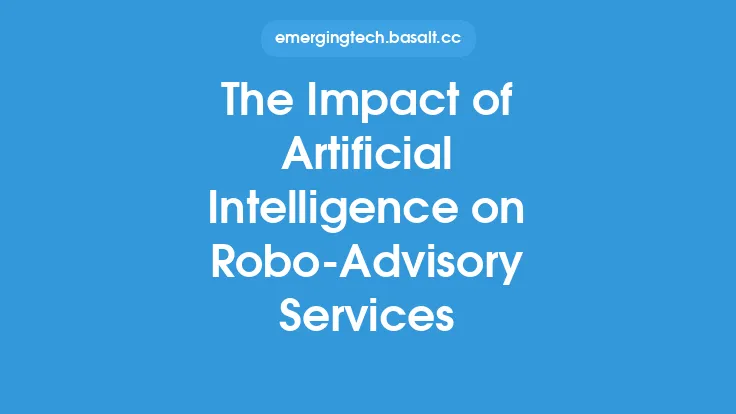The financial services industry has witnessed a significant transformation with the emergence of robo-advisory platforms, which leverage technology to provide automated, algorithm-driven financial planning services to individuals. As the robo-advisory landscape continues to evolve, it is essential to examine the trends and predictions that will shape the future of this industry. In this article, we will delve into the key developments that will influence the growth and adoption of robo-advisory services, highlighting the opportunities and challenges that lie ahead.
Introduction to Robo-Advisory
Robo-advisory platforms use advanced algorithms and machine learning techniques to provide personalized investment advice and portfolio management services to clients. These platforms typically offer low-cost, efficient, and transparent investment solutions, which have resonated with a new generation of investors. The robo-advisory market has experienced rapid growth in recent years, with assets under management (AUM) increasing significantly. As the industry continues to expand, it is crucial to understand the underlying trends and predictions that will drive its future development.
Trends in Robo-Advisory
Several trends are expected to shape the future of robo-advisory, including the increasing adoption of artificial intelligence (AI) and machine learning (ML) technologies. These technologies will enable robo-advisory platforms to provide more sophisticated and personalized investment advice, taking into account a broader range of factors, such as market trends, economic indicators, and individual investor preferences. Another trend is the growing demand for hybrid robo-advisory models, which combine the benefits of automated investment platforms with the expertise of human financial advisors. This hybrid approach is expected to become increasingly popular, as investors seek a more personalized and comprehensive investment experience.
Predictions for the Future of Robo-Advisory
Looking ahead, several predictions can be made about the future of robo-advisory. One prediction is that robo-advisory platforms will become more integrated with other financial services, such as banking, payments, and lending. This integration will enable robo-advisory platforms to offer a more comprehensive range of financial services, making them a one-stop-shop for investors. Another prediction is that robo-advisory platforms will place greater emphasis on sustainability and environmental, social, and governance (ESG) considerations. As investors become increasingly conscious of the social and environmental impact of their investments, robo-advisory platforms will need to adapt to meet this demand, providing more ESG-focused investment options and greater transparency around investment decisions.
Technological Advancements in Robo-Advisory
Technological advancements will play a crucial role in shaping the future of robo-advisory. One key area of development is the use of blockchain technology, which has the potential to increase transparency, security, and efficiency in investment transactions. Another area of development is the use of natural language processing (NLP) and chatbots, which will enable robo-advisory platforms to provide more intuitive and user-friendly interfaces, making it easier for investors to interact with the platform and access investment advice. Additionally, the use of cloud computing and big data analytics will enable robo-advisory platforms to process vast amounts of data, providing more accurate and personalized investment recommendations.
Regulatory Environment and Robo-Advisory
The regulatory environment will also play a significant role in shaping the future of robo-advisory. As the industry continues to grow, regulators will need to adapt to ensure that robo-advisory platforms are operating in a fair, transparent, and secure manner. One key area of regulatory focus will be the protection of investor data, with regulators imposing stricter requirements around data privacy and security. Another area of focus will be the regulation of AI and ML technologies, with regulators seeking to ensure that these technologies are used in a responsible and transparent manner. Robo-advisory platforms will need to navigate this evolving regulatory landscape, ensuring that they comply with relevant regulations and maintain the trust of their investors.
Conclusion
In conclusion, the future of robo-advisory is exciting and rapidly evolving. As the industry continues to grow and develop, it is essential to stay informed about the trends and predictions that will shape its future. From the increasing adoption of AI and ML technologies to the growing demand for hybrid robo-advisory models, there are many factors that will influence the development of this industry. By understanding these trends and predictions, investors, financial institutions, and regulators can work together to create a more efficient, transparent, and secure robo-advisory landscape, providing better outcomes for investors and driving the growth of the financial services industry as a whole.





